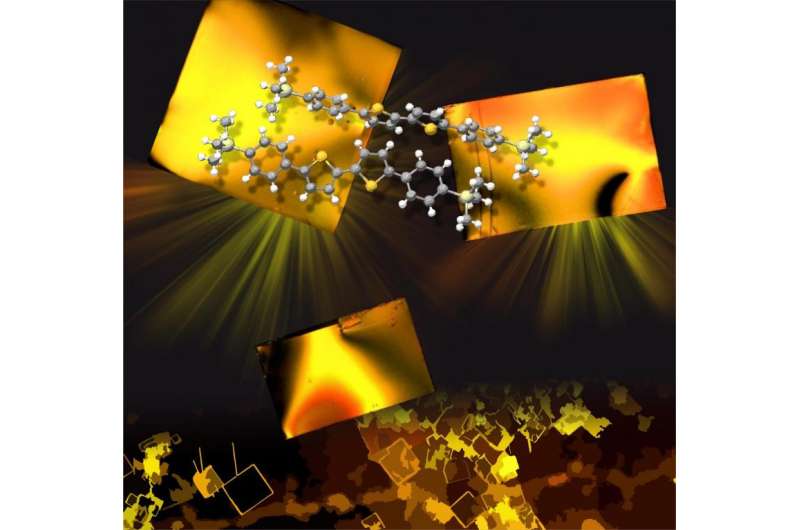Organic crystals allow creating flexible electronic devices

Scientists from the faculty of physics of the Moscow State University have grown organic semiconductor crystals that can reduce the cost of creating light, flexible and transparent light-emitting electronic devices. The researchers, in cooperation with Russian and foreign colleagues, have grown organic semiconductor crystals with extremely high light-emitting efficiency that promise a bright future for wet-processed organic optoelectronics.
Moreover, they made a double breakthrough using much simpler and cheaper technologies that previously were considered impractical. The scientists have published the results of their work in the latest issue of the Applied Materials and Interfaces journal.
The organic optoelectronics is a rapidly growing area that promises light, flexible and transparent next-generation electronic devices, such as organic light-emitting transistors (OLET) and organic lasers pumped by electric current. Organic semiconductors, due to their availability, can even replace silicon in some electronic applications.
Researchers have pursued organic semiconductor crystals grown from a vapor phase process, since those obtained from vapor are purer and free of structural impurities characteristic of crystals grown from solution. A group of physicists from the Moscow State University, led by Professor Dmitry Paraschuk, now challenge this opinion for several reasons, particularly because of much simpler and cheaper technologies for solution-grown crystals.
In their study, so called thiophene-phenylene oligomers were chosen as work-horse molecules. The desired molecules were synthesized for them by chemists from Moscow State University and the Enikolopov Institute of Synthetic Polymeric Materials of RAS. At the faculty of physics, crystals were grown from solution of these molecules. Their luminescent and electrical properties were measured there, as well.
The main results of this study determined that the solution-grown crystals are more luminescent than their analogues obtained from vapor. Their quantum yield (i.e. the ratio of the number of photons emitted to the number of absorbed ones) reached 60 percent, whereas vapor-grown crystals presented no more than 38 percent.
Such a striking difference in luminescence efficiency is partly explained by the fact that during the solution growing process, some internal radiationless channels that excite energy are suppressed in crystals. But apparently, this is not the only explanation.
"We have found reasons for such a high quantum yield, but we are not ready to publish these yet. This is a subject of our future studies," said Professor Paraschuk.
It is noteworthy that despite all previously known disadvantages of the solution-growing techniques, the new study addressed their advantages compared to the vapor-growing methods of crystals. In one of the recent studies, Paraschuk's group determined that crystals can be grown on the surface of the solution instead of a solid substrate due to the surface tension forces.
"We have shown that it is possible to grow crystals on the surface of the liquid in different ways. Roughly speaking, after we place a solution with molecules in a vessel and then begin to cool it, under some certain conditions, we allow molecules to be deposited on the surface at the air-liquid interface. Because the liquid surface is almost perfect, the crystals grown on it are of good quality, and owing to their high electronic performance, they are preferable to the vapor-grown ones. Moreover, the surface of the solution-grown crystals is molecularly smooth with angstrom-scale roughness, which allows us to create field-effect transistors of high quality," says the professor.
Dmitry Paraschuk emphasizes that the applicability of the crystals in light-emitted transistors, and therefore in organic optoelectronics is just a suggestion, the validity of which is still to be proved. The group also speculates about creating lasers controlled by electric current obtained on the same basis.
"People dream of building lasers that can ignite by simple connection of the film to the power source, but they haven't succeeded yet, said Paraschuk."We hope that with the help of organic crystals, we can reach this goal. The combination of good conductivity and high efficiency allows us to hope that the first electrically pumped laser will be created on the basis of such crystals."
More information: Lyudmila G. Kudryashova et al. Highly Luminescent Solution-Grown Thiophene-Phenylene Co-Oligomer Single Crystals, ACS Applied Materials & Interfaces (2016). DOI: 10.1021/acsami.5b11967
Journal information: ACS Applied Materials and Interfaces
Provided by Lomonosov Moscow State University





















